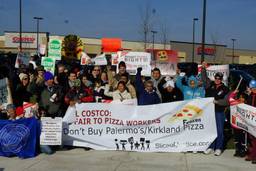Center for Union Facts Steps Up $10 Million Ad Campaign Backing Broad Anti-Union Bill
Josh Eidelson
Anti-union group’s website encourages workers to decertify unions, while claiming decertification is “nearly impossible.”
“I’m sick of the union taking so much of my money out of every paycheck,” Frank tells his co-worker Bob. “I don’t know why you voted them in.” “Don’t look at me,” Bob responds. “I never even got a vote.” Bob then polls fellow auto repair shop employees, and they all say they got hired long after the union election. “Only 10 percent of people in unions today actually voted to join a union,” declares a narrator. “Everyone deserves a vote at least one time.”
As this TV ad ends, a worker chides the one remaining employee who might have voted in the union: an old man whom we see fumbling with his equipment.
This commercial, which aired during one of this month’s presidential debates, is one of four in a new campaign from the anti-union Center for Union Facts. CUF pledged last month to spend $10 million on the campaign, which promotes a new “Employee Rights Act” introduced in Congress by Utah Senator Orrin Hatch and South Carolina Congressman Tim Scott. The ERA’s provisions are an anti-union wish list, including restricting “non-representation” spending by unions, banning any union recognition process other than an NLRB election, and requiring members to vote every three years on whether to eliminate their union. Politico reported yesterday that CUF is launching a new phase of its campaign supporting the bill this week.
The CFU was founded six years ago by Rick Berman, who as a food and beverage industry lobbyist famously denied that high soda consumption is a cause of diabetes. In 2006, Berman told the New York Times that he had urged the staff of local Chambers of Commerce to advise businesses to make contributions to CUF.
CUF’s campaign also features a full-page New York Times ad comparing union members to subjects of the North Korean dictatorship. Asked to explain the comparison, CUF Managing Director Justin Wilson says that because they started work once the union had already been voted in, “90 percent of the people in labor unions have had about the same degree of opportunity to express a democratic interest in the unions that represent them as the people in North Korea.”
Kate Bronfenbrenner, director of Labor Education at Cornell University, questions CUF’s math and its logic. “Does North Korea have Duty of Fair Representation?” retorts Bronfenbrenner, referring to unions’ obligation under federal law to represent members without discrimination. “No other institution has that standard…Union records are open, all officers are elected, and all contracts are voted on.”
Bronfenbrenner says unions “have a lot of problems,” and “could be more inclusive,” but in terms of democracy, “they’re better than corporations, they’re better than nonprofits, they’re better than the U.S. government, they’re certainly better than academia – it’s just that they need to hold themselves to a higher standard” than any of those institutions.
CUF’s Wilson says the ERA provision he finds “the most interesting” is the requirement for re-certification votes by members every three years on whether to eliminate their union. “Why shouldn’t unions have to stand occasionally for re-election?” asks Wilson.
Bronfenbrenner, who studies union and employer behavior during union elections, says a requirement of regular elections would remove employers’ incentives to cooperate with the union, even on the resolution of workplace issues like scheduling around cancer treatments, because managers wouldn’t “want to do anything that would make the union look like it could accomplish anything.” Instead, says Bronfenbrenner, workers could expect the same anti-union intimidation tactics that characterize union recognition elections to become a permanent feature of their workplace.
Though CUF’s ad doesn’t mention it, union members already have the opportunity at least every three years to force a new election by filing a petition with the signatures of 30 percent of their co-workers. The disgruntled auto repair workers portrayed in the ad could learn about this on CUF’s website, although they’ll come away with different impressions depending on which section they visit.
The site includes a page on “How to Decertify Your Union,” which notes that such elections “are not rare – several hundred take place in a typical year.” “In 2004,” says the same page, “workers successfully decertified poor representation in 65 percent of decertification elections, according to cases closed by the NLRB.” It also offers “Sample Decertification Forms” (although the link appears currently inactive). But the EmployeeRightsAct.Com sister site run by CUF strikes a different tone: “Once a workplace is unionized, it is nearly impossible for employees to decertify a union.”
Wilson describes the decertification process as “so difficult and time-consuming and expensive.”
Similarly, while another CUF ad depicts an outraged union member spitting out his coffee in anger that his union dues fund contributions to a certain politician, CUF’s FAQ page informs union members that under the Supreme Court’s Beck ruling, if union-represented workers “object to the use of their money for things that are not directly related to collective bargaining, they are entitled to a refund of the portion of their dues spent on politics and other non-bargaining activities.”
Wilson says that the “Paycheck Protection” part of the ERA would distinguish between representation and nonrepresentation costs in a similar manner to that under Beck, but “allow employees to opt-in as opposed to opt-out.” When employees who opt-out under Beck, their dues are barred for use not only for politics, but also for organizing new members.
The proposed ERA bill would also reverse the effect of the NLRB’s new election rule by requiring at least 40 days between when workers file for an election to win a union and when the election can be held. Wilson says that much time is necessary to ensure that workers “hear from both sides.” He claims employers need to retain professional consultants just to avoid accidentally breaking the law while campaigning against a union, and complains that new Department of Labor Disclosure requirements make such hiring more cumbersome. Bronfenbrenner responds that employers learn about organizing campaigns long before workers file for election, noting that nearly half of serious Unfair Labor Practice charges against employers in organizing campaigns are filed before any election petition.
As I’ve reported, the anti-union Labor Relations Institute is suggesting clients conduct five captive audience meetings during the newly shortened election period. Asked whether five such meetings is enough of an opportunity for management to get its view across, Wilson responded, “I have no idea. I can’t speak to it. I’ve never really been involved” in such a campaign.
With concrete stories and clear enemies, the approach of the CUF ads contrasts sharply with a smaller ad campaign launched this month by the AFL-CIO with phrases like “Work…it’s the initials we scratch in the wet cement of America’s progress.” The AFL-CIO blog wrote that the federation’s campaign “aims to ‘fly above the tactics and controversies of the day’ and connects with people around the values associated with work, according to AFL-CIO Secretary-Treasurer Liz Shuler.”
Though the ERA may help Senator Hatch fend off a primary challenge, it’s unlikely to escape the Democratic-controlled Senate. But as conservatives push anti-labor state bills and resist pro-labor changes at the federal level, $10 million depicting unions as uninvited dictatorships can’t hurt their efforts.
Asked whether CUF’s campaign is intended to salt the earth for future efforts at pro-union labor law reform, Wilson says that’s unnecessary, noting that while the ERA has been introduced in both the House and Senate in the current Congress, the Employee Free Choice Act — the “card check” legislation that failed to become law in 2007 and 2009 — hasn’t.






